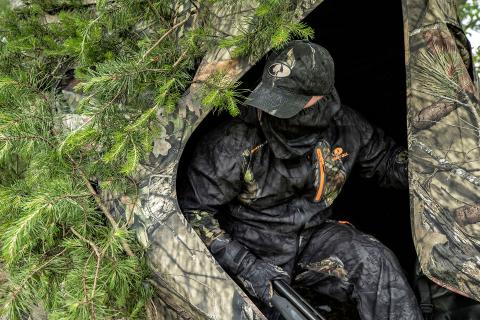Brenda Valentine | Originally published in GameKeepers: Farming for Wildlife Magazine. To subscribe, click here.
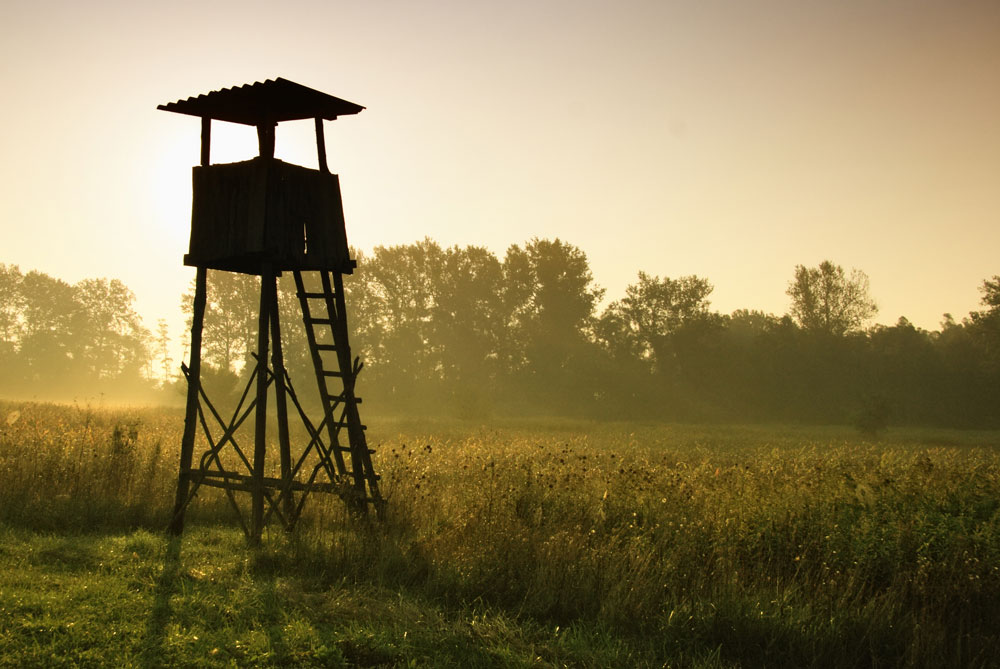
Is it possible to have a permanent stand that can be hunted more than a few times a season without impacting deer movement too much? After a few decades of doing the “deer-stand shuffle” while I was evolving into a wiser hunter, I have learned that “yes,” this is entirely possible. However, there are several areas of consideration in the pursuit of a perfect permanent deer stand that must be addressed before this can be achieved.
The first step for establishing a stand site that is productive season after season should include an evaluation of the area deer herd, careful planning for entry and exits routes, thermals and prevailing wind direction in your area, seasonal food supplies, fall/winter bedding locations as well as your intended method of hunting.
With the recent popularity of comfortable shooting houses that protect you from the elements in addition to confining odor, it is only practical to place them in choice locations where they can be enjoyed year after year while waiting on that big buck. Sturdy ladder stands can be extremely productive but they are not easily repositioned so pay careful attention to where and how you set them up for optimal hunting.
A lot of valuable stand placement information can be gleaned from maps and trail cameras, but nothing beats hunting a property for a season or two to get in real touch with deer movement and seasonal patterns due to food supplies or hunting pressure. I learn more by simply sitting in a stand observing whitetails both in and out of season than I've ever been able to figure from a map.
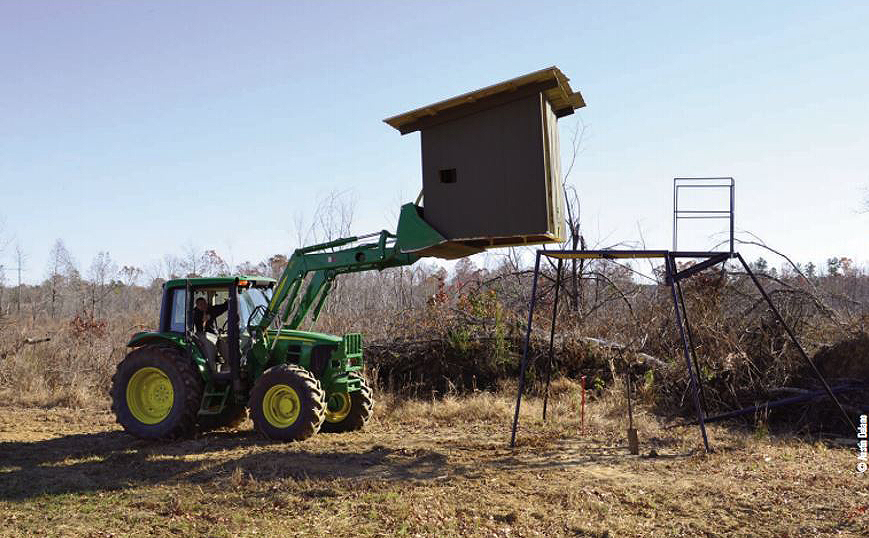
Pieces of the puzzle begin to unravel when you see where bucks emerge onto a field, or where does dash off for security when threatened by predators or being chased during the rut. It is also informative to learn where deer seek cover during extreme weather. Available, and/or preferred food sources during hunting season is also a must-know for successful stand placement. The size of your hunting area, deer density and the terrain play into the equation as well. Whether you plan to hunt with gun or bow, or both, must also be factored.
Knowing your neighbors and where they hunt in proximity to you can make or break an otherwise sound stand location. The length of the hunting season in your area is another major factor to think about for keeping your stand productive. Compare the pressure issues of repeatedly hunting stands in states where deer season lasts only a few days to those, such as where I live, that lasts a few months. Determine if you are a morning, an evening, an all-day hunter or maybe some of each.
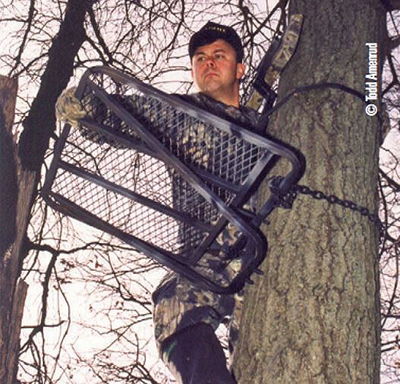
treestand, wind direction should be your major concern.
All of these bits of important info are enough to make a person dizzy and probably overwhelm the newcomer to the point of throwing up their hands and sticking their stand in the first easy place then wondering what went wrong after a couple of unproductive sittings. Where and how does a hunter find that perfect spot for a permanent deer stand? Where he or she will have the confidence to patiently put in the time to get that perfect shot? This brings me to another important point — it's not enough to place a stand in a prime place for seeing deer. That is actually only an observation tower. Winning tree stand placement has to assure you optimal shooting opportunities. Here are the things I look for first when nailing down THE place to put a permanent stand.
- Wind direction. Wind direction. Wind direction. Know the prevailing wind direction for fall and winter in your area. Use a compass to verify this direction when scouting for the perfect stand site. It is also good to note sunrise and sunset angles at this time. 90 percent of my stands are set for a west, northwest or southwest wind since that is how the breezes blow here in Tennessee 90 percent of the time.
- Have an approach plan when choosing a stand site. Think about how you can get to your stand undetected by sight, smell or sound. Sometimes this means planting shrubs or tall grass to hide your entry or clearing a path through the woods, but it always means getting to your stand with the wind in your face. Here is where the maps and compass are handy, I approach almost every stand from the east along brushy fencerows, standing corn or cleared paths in timber. A pressure spray of herbicide during the summer is the fastest way I know of clearing a path to my fall stand. An old-fashioned leaf rake is the best tool for making a quiet walk to the stand when it is located in the winter woods carpeted with crunchy leaves.
- Exiting a stand undetected is just as important as entering it. Some hunters mistakenly feel it is okay to blow deer out of a field at dusk when the hunt is over. This not only gives away your location causing them to skirt the area in the future, but will make mature deer nocturnal as quick as anything. Tuck your stand back off a food plot or open field so as not to disturb feeding deer in the late afternoon when shooting hours are over. It is never wise to situate a stand in the middle of a large open field with perhaps maybe one exception. If there is a road running through the field where vehicles are a common sight and a hunter is dropped off and picked up by vehicle is the only situation where deer won't soon wise up to the stand and vacate the area during daylight hours.
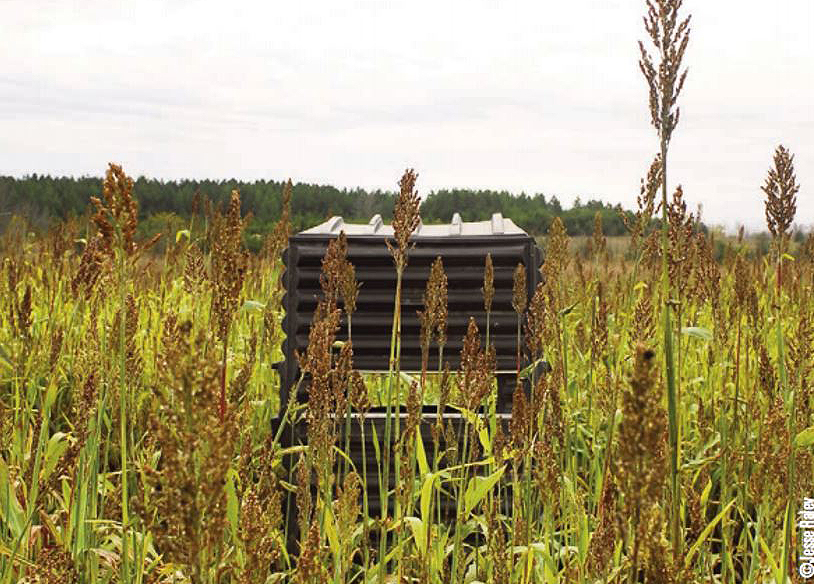
Your stand approach and how you exit an area are extremely important. A screen of tall grass like BioLogic’s Blind Spot will help you to remain concealed while traveling in and out of the area. - Morning, mid-day and early afternoon stands are ideally placed between bedding and food. I prefer a transition zone that is not too close to where the majority of whitetails will start moseying through soon after daylight headed to their secure bedding area. Strips of open timber between crops, thickets or swamps are excellent ambush sites. Deer usually get up and browse around these areas throughout the day if undisturbed. During the rut, this is always a high action place to hunt when bucks are frantically roaming from one doe group to the next.
- Few stand sites are ideal for both bow and firearm due to the need to get close when hunting with a bow…but there are exceptions. Typically these sites are located along travel routes with squeeze points or funnels. Look for established creek crossings, major changes in topography, openings in fences or narrow fingers of brush and timber where deer can cross open fields undetected. Any place that forces deer to use the same trail over and again is a likely place for a permanent stand provided it meets the criteria mentioned in the first four points.
- Be very tree selective when setting a ladder or lock-on stand. Look for trees with structure to break up your outline and hide movement. Think about how the area will look in winter when trees are bare. When given the option, I prefer cedar or other evergreen trees for placing open stands due to their natural scent-covering odor and their all-season cover. For early fall bow season it is hard to beat an ancient oak with gnarly limbs to keep you hidden. I have come to depend on the Ozonics in-the-field ozone generator to destroy traces of my scent from lingering near the stand. If you are unsure if your selected site meets all the criteria for becoming a permanent stand location I suggest trying a pop-up portable blind for a while provided it is in place well before the season to allow time for deer to become accustomed to it. Once you have nailed down the perfect place and the stand is in place there are a few common sense rules that will keep it fun and productive to hunt for many seasons.
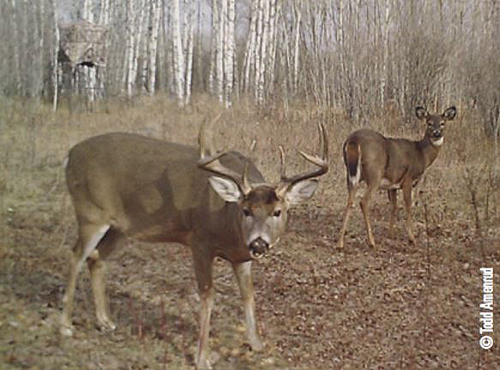
An option that is becoming more popular is a free standing platform with a
regular pop-up blind rather than a box-blind (left background). It’s a bit
easier to move than the larger, heavier box blind. - Keep it clean. Although you may choose to spend a good deal of time at your now favorite stand don't litter with food, trash or human wastes. Pack it in and pack it out every trip.
- Refrain from frequent walkabouts or scouting trips in the vicinity during hunting season. Use your binoculars or a spotting scope to scout from the stand.
- Place die-cut netting, brushy limbs or other camo material around open treestands to camouflage your outline and hide movement.
- Most important of all — always buckle-up — and wear an approved treestand fall restraint device such as the Hunters Safety System when hunting from an elevated stand. Routinely inspect ratchet straps, chains or whatever you secure the stand to the tree with. Look for wear, rodent damage, tree growth that will break or weaken any type of fastening as well as dead limbs hanging above your head.
Now that you’ve achieved perfect tree stand placement, sit back and enjoy the hunt with confidence, knowing you are in the best possible location for putting meat in the freezer or a trophy on the wall. Plus, you don't have to worry about who you are going to get to help you move that stand again next year.



















